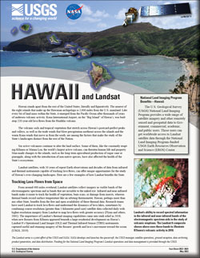Hawaii and Landsat
Links
- Document: Report (3.23 MB pdf) , HTML , XML
- Download citation as: RIS | Dublin Core
Abstract
Hawaii stands apart from the rest of the United States, literally and figuratively. The nearest of the eight islands that make up the Hawaiian archipelago is 2,000 miles from the U.S. mainland. Like every bit of land mass within the State, it emerged from the Pacific Ocean after thousands of years of undersea volcanic activity. Kona International Airport, on the “Big Island” of Hawai‘i, was built atop 220-year-old lava flows from the Hualālai volcano.
The volcanic soils and tropical vegetation that stretch across Hawaii’s postcard-perfect peaks and valleys, as well as the trade winds that blow precipitation northeast across the islands and the warm Kona winds that move in from the south, are among the factors that make the study of the State’s landscapes distinct from the rest of the Nation.
Six active volcanoes continue to alter the land surface. Some of them, like the constantly erupting Kīlauea or Mauna Loa, the world’s largest active volcano, can threaten human life and property. Man-made changes to the islands, such as the long-term agricultural production of sugar cane or pineapple, along with the introduction of non-native species, have also affected the health of the State’s ecosystems.
Landsat satellites, with 50 years of repeat Earth observations and decades of data from infrared and thermal instruments capable of tracking lava flows, can offer unique opportunities for the study of Hawaii’s ever-changing landscapes. Here are a few examples of how Landsat benefits the State.
Suggested Citation
U.S. Geological Survey, 2022, Hawaii and Landsat: U.S. Geological Survey Fact Sheet 2022–3024, 2 p., https://doi.org/10.3133/fs20223024.
ISSN: 2327-6932 (online)
ISSN: 2327-6916 (print)
Study Area
Table of Contents
- Tracking Lava Flows from Space
- Monitoring Land Change Patterns
- Mapping Land Conditions
- Landsat—Critical Information Infrastructure for the Nation
- References Cited
| Publication type | Report |
|---|---|
| Publication Subtype | USGS Numbered Series |
| Title | Hawaii and Landsat |
| Series title | Fact Sheet |
| Series number | 2022-3024 |
| DOI | 10.3133/fs20223024 |
| Publication Date | May 04, 2022 |
| Year Published | 2022 |
| Language | English |
| Publisher | U.S. Geological Survey |
| Publisher location | Reston, VA |
| Contributing office(s) | Earth Resources Observation and Science (EROS) Center |
| Description | 2 p. |
| Country | United States |
| State | Hawaii |
| Online Only (Y/N) | N |


